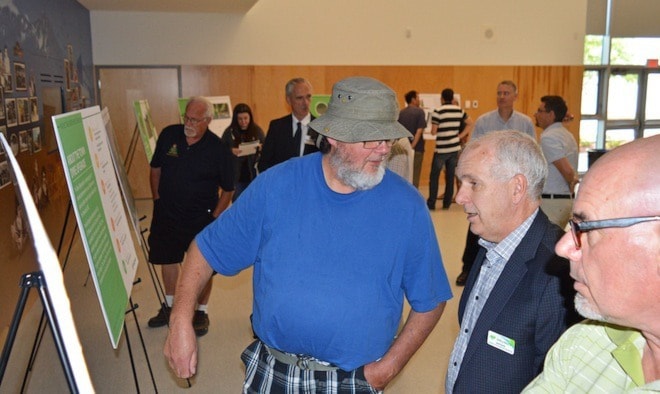Extensive planning to raise the dike by one metre from Young Road at the Hope Slough, to the base of Chilliwack Mountain, kicked off this week with public meetings.
Construction on the multi-million dollar Town Dyke project will only start once funding is secured from senior levels of government. That could take a while, said officials, and there's no start date in sight yet.
Meanwhile two public information sessions held Tuesday got some public dialogue going.
Three design possibilities were up on display boards, and the meeting was held to allow the community to learn about the design process, lead by Urban Systems senior engineer Glen Shkurhan.
"We have not started any design work yet," he said. "There is still technical work to do."
 That "technical work" will include field work like site reconnaissance, arborist assessment, topographic and geotechnical work along the trail.
That "technical work" will include field work like site reconnaissance, arborist assessment, topographic and geotechnical work along the trail.
Two of the design concepts would use "earth fill" to raise the dike, and #3 featured a barrier wall. Some of the options would retain more of the Rotary Trail trees than others, like Concept #3 that would include building a barrier wall along the trail fence line.
"There are lots of trees so we want arborist to help," said Shkurhan. That work will inform the design process.
Residents raised a range of concerns at the meetings, from dike alignments, and protection of local First Nations, to impacts on the Rotary Trail section in Hope-Corbould Park, on habitat or the trees.
Shkurhan said up front that the team was aware of some public comments and controversy already being discussed about the dike work skirting First Nation land.
"We understand that Skwah First Nation has recently initiated its own flood protection strategy, so there are some parallel activities taking place," he said.
The goal is raising the elevation by one metre to bring it up to provincial standards, as part of ongoing improvements to Chilliwack's vast 50-km diking system.
There is no set schedule yet for construction on the project that could cost about $10 million, but the public outreach and consultation has begun on the Rotary Trail section, with the community meeting hosted June 28 by city officials and consultants Urban Systems.
There are five homes along Berkeley Avenue, where the city has no right of way, and no flood protection structure exists. Those property owners will be participating in meetings this summer.
 Both community and one-on-one meetings will be held with various stakeholders, until the consultants pinpoint design concepts “worthy of pursuit.”
Both community and one-on-one meetings will be held with various stakeholders, until the consultants pinpoint design concepts “worthy of pursuit.”
The final preliminary design is expected by December.
The scope of Town Dyke work will exclude the sections of Skwah First Nation land, as well parts of the Shxwhá:y Village (Skway First Nation).
City officials said discussions with Skwah and Shxwha:y will be ongoing, seeking collaborative solutions.
"We've just started looking at this after receiving funding for a flood mitigation study," confirmed Skwah band official Lory Oberst, after the meeting.
"We'll be looking at the various possibilities, where diking is one of the options."
Chilliwack Resident Bryden Nelmes said while he doesn't live near the site, he's interested in community projects like this.
"I like to stay informed and see what's going on."
At this early stage, he said his preference was for Concept #3, where the plan was to construct a barrier wall, and preserve most of the existing trees.
"That would seem to be a good compromise that would satisfy the majority who live nearby, as well as protecting the city."
City reps said they wanted to let area residents, impacted home owners, and the community, in on the early stages of the design process.
"The City knows the importance of communicating with community members in advance of design," according to the meeting handout.
Chilliwack resident Ian Stephen said he attended the afternoon session to "get caught up" with where they project was going.
"I was glad to hear the city is involved with the technical flood committee for the Fraser Basin Council," he said. "The more coordinated things are on a regional scale, the more efficient the flood protection will be. It's such a huge issue regionally, with so many millions at stake."
To fill out the survey on the Town Dyke to offer suggestions or concerns: go to http://www.fluidsurveys.com/s/towndyke/
